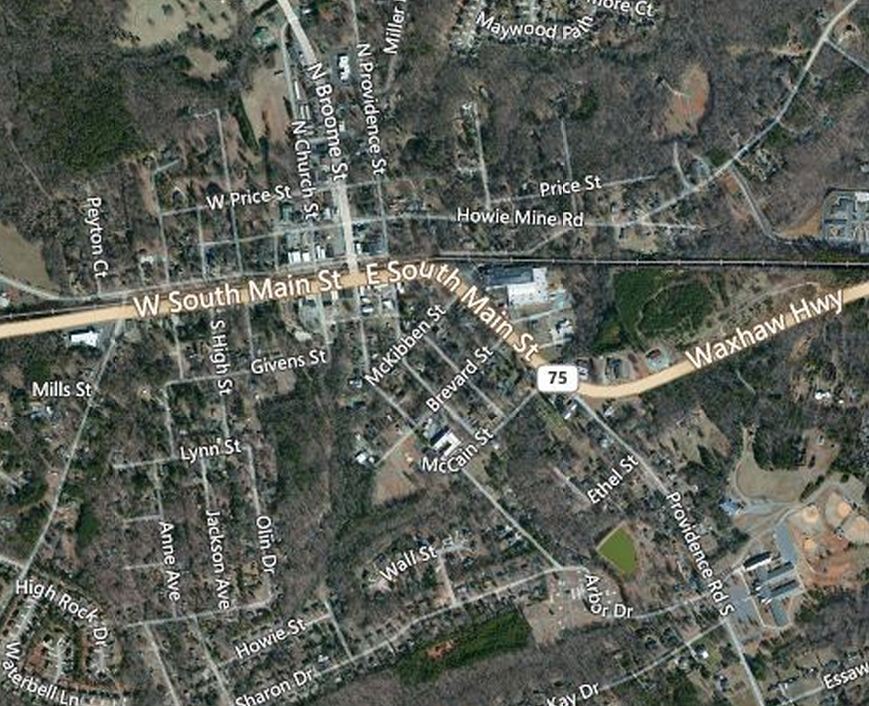Waxhaw looks to future for N.C. 16 plan

WAXHAW – The question came from the back row of the small audience, during a presentation from planning consultants about the future for N.C. 16 as it bisects the fast-growing Union County town.
“If we do all this, will we still be considered a small town?”
Consultant Monica Holmes of Lawrence Group paused briefly before answering:
“A very important part of this discussion is, ‘What does Waxhaw want to be?’ ”
Old-timers in these parts may still think of Waxhaw as a 19th-century railroad hamlet at the terminus of Providence Road, with enough antique shops to make it worth a pleasantly rural half-hour drive from Charlotte. Anyone who’s been to Waxhaw in the past 15 years knows better. Waxhaw’s growth is exploding, and to reach its still quaint downtown from Charlotte means as much as an hour’s drive past suburban shopping centers, big-box stores and multiple subdivision entrances.
In 2000, Waxhaw had 2,200 people. By 2010 it was almost 10,000; the 2012 U.S. Census estimate is 10,334. In other words, from 2000 to 2012 it has grown 370 percent – almost fourfold. Chris Rice, one of the town’s planners, said they estimate its 2013 population is about 14,000, and it’s on track to add at least 500 new homes this year based on building permits. At an average of three people per household, that’s a population increase of 1,500 this year alone.
Further, as Holmes told the crowd of about two dozen Waxhaw residents who came to hear the consultants’ recommendations, the town has already approved some 4,000 still-to-be-built residences. “You’re going to double in size in the next 10 years,” she said. Because those houses have already been approved, she said, “Legally you cannot stop that from happening.”

Waxhaw is not the only town in the Charlotte region wrestling with what it wants its future to be. But its growth trajectory is one of the steepest. Between 2000 and 2010 Waxhaw went from the 42nd-largest municipality in the Charlotte region to No. 25. (See Census 2010: Cities and towns in the Charlotte region.) If Waxhaw now has 14,000 people, that means the onetime hamlet is larger than Lincolnton, Belmont or Davidson.
The consultants, though, weren’t there to answer the existential questions that beset one-time small towns in the orbit of a fast-growing city. Their task was to help the town envision a different future for about 3 miles of N.C. 16 and development in a half-mile-wide space alongside it. But behind many of the recommendations loomed those big questions: Who does Waxhaw want to be? And how can it manage the growth that is coming?
The recommendations for Waxhaw were split into four general areas: transportation, market, infill strategies and regulatory strategies. Following are highlights:
Transportation
A 2009 regional transportation plan for western Union County, done with Marvin, Weddington and Wesley, envisions a four-lane boulevard along N.C. 16 from Weddington to Waxhaw Parkway, as well as better bicycle and pedestrian amenities.
Among the consultants’ recommendations:
1. Build better connections, with more connector streets and a network of local streets. Holmes pointed out that in Waxhaw, for most daily trips – home, shopping, school, work, etc. – “people are making most of those trips by cars. … Everybody has to use 16.” That clogs the highway. Connected streets between neighborhoods would lessen the congestion.

She pointed to the connected, grid pattern in the town’s historic core (on the National Register of Historic Places) as a model for reducing highway congestion.

2. A traffic circle at Waxhaw Parkway where four lanes would narrow to two.

3. A walking and biking path and trees beside the highway.
4. “A corridor of different experiences,” moving from rural at the north end to a more urban boulevard. “Right now it’s one experience: grass,” she said. “That’s the DOT special.” A different appearance would help keep Waxhaw distinctive. “Waxhaw does not want to be Anywhere USA,” she said. “You want to set yourself apart.”
Market
Census figures show that Waxhaw residents aren’t representative of the state as a whole: 82 percent are white compared with 68.5 percent statewide; 11 percent are black, compared with 21.5 percent statewide. Waxhaw’s homeownership rate is 86 percent; the N.C. rate is 68 percent. Its median household income is $73,000, compared with $46,000 statewide.
Holmes pointed to a nonscientific town survey that found 39 percent of respondents said they moved there for the schools, which means many residents have young children. Census figures show 35 percent of residents are younger than 18, compared with 24 percent statewide.
A market study from Atlanta-based Noell Consulting Group found the Waxhaw area has captured a third of all Union County’s household growth but isn’t attracting singles – the biggest growth segment in Mecklenburg County. It also said the town is already zoned for almost as much retail space as it will need until 2030. “There is little need for new retail zoned land until 2020 or beyond,” the Noell report said.
Among the Lawrence Group’s recommendations:
1. Diversify housing choices for a changing residential market. “Waxhaw right now is a very single-product town,” Holmes said. The Noell report said a large, growing segment of the market wants walkable and lively environments.

2. Balance market demand with the community’s vision.
Infill strategies
The consultants recommend:
1. Preserving Waxhaw’s small town character through strategic growth.
2. Creating well-designed nodes of mixed-use development in walkable environments.
Regulatory strategies
As the consultants’ presentation drew to a close, someone in the audience said, “It’s great to have a little booklet with all the plans but you have to have ordinances … or nothing comes to fruition.”
Zoning and town codes, Holmes responded, are the best way to ensure that plans come to fruition.
